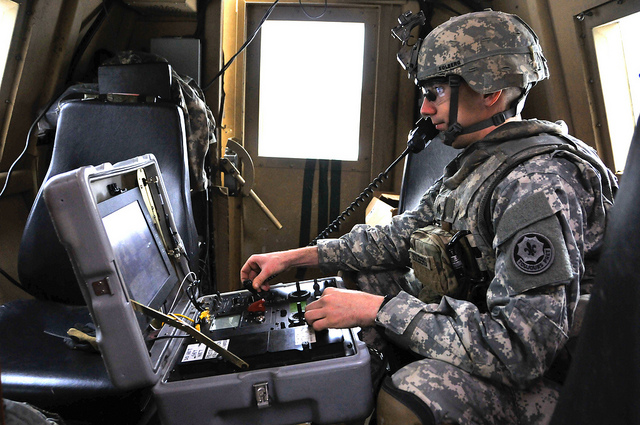ASPI suggests
Posted By Natalie Sambhi on February 21, 2014 @ 14:55
We’re kicking off today’s round-up with an interesting article on the complex relationship between military robots and their soldiers [2]. Here’s an excerpt:
From holding elaborate funerals [3] for robots, complete with 21-gun salutes, valor medals, and memorial markers, to identifying with them as “an extension of our own personality,” as Simon, a Marine sergeant, says, soldiers are now working effectively with robots on a more intimate level than in perhaps any other field, saving human lives in the process.
These anecdotes above derive from new research at the University of Washington on human-robot interactions. And given the prevalence of machines on the battlefield (like counter-IED robots like TALON operated in the image above) and new projects like humanoid robots [4] in the pipeline, understanding feelings they evoke in soldiers, whether creativity or distrust, is crucial.
If you’re into research, the Stockholm International Peace Research Institute (SIPRI) has a useful database, Facts on International Relations and Security Trends (or FIRST) [5], which provides statistics and information on the world’s armed forces, country indicators like education and population, and nuclear weapons, to name a few.
In case you missed it, the Commission of Inquiry on Human Rights in the Democratic People’s Republic of North Korea (headed by Australia’s Justice Michael Kirby) released its report [6] on Monday. Earlier in the week, ASPI’s Hayley Channer wrote about the report’s potential impact on the country’s humanitarian conditions [7], arguing that it places further pressure on the regime and on China to do more about refugees.
Sticking with the UN report on North Korea’s human rights abuses, Stephen Haggard at the Peterson Institute for International Economics asks ‘if this is not a circumstance in which to invoke the responsibility to protect, what is?’ [8]
Fans of the US rebalance will be watching the development of the FY 2015 budget submission with interest. Defense News is reporting [9]that the centrepiece of US power projection—a nuclear aircraft carrier and its embarked air wing—might still be in the negotiating mix.
Season two of the wildly popular US political drama House of Cards began last week. Over at Defense One, Harry Kazianis looks at how a fictional East China Sea crisis in the show [10] reflects the real world challenge America may face in projecting power near China. For more, keep reading here [10].
Lastly, what do armies eat? The Guardian sampled Army ration packs from 11 countries [11] to see which was the most palatable. The winning ‘rat pack’ came from Italy.
Natalie Sambhi is an analyst at ASPI and editor of The Strategist. Image courtesy of Flickr user The US Army [12].
Article printed from The Strategist: https://www.aspistrategist.org.au
URL to article: https://www.aspistrategist.org.au/aspi-suggests-21-feb/
URLs in this post:
[1] Image: http://www.aspistrategist.org.au/wp-content/uploads/2014/02/8498016622_5b514455cd_z.jpg
[2] complex relationship between military robots and their soldiers: http://mag.newsweek.com/2014/02/21/military-robots-increase-complexity-relationship-soldiers.html
[3] elaborate funerals: http://www.theatlantic.com/technology/archive/2013/09/funerals-for-fallen-robots/279861/
[4] humanoid robots: http://www.theverge.com/2014/1/28/5339246/war-machines-ethics-of-robots-on-the-battlefield
[5] Facts on International Relations and Security Trends (or FIRST): http://first.sipri.org/
[6] released its report: http://www.ohchr.org/EN/HRBodies/HRC/CoIDPRK/Pages/ReportoftheCommissionofInquiryDPRK.aspx
[7] wrote about the report’s potential impact on the country’s humanitarian conditions: http://www.aspistrategist.org.au/tipping-the-scales-not-yet/
[8] ‘if this is not a circumstance in which to invoke the responsibility to protect, what is?’: http://blogs.piie.com/nk/?p=12902
[9] reporting : http://www.defensenews.com/article/20140126/DEFREG02/301270019/Carrier-Cut-Could-Back-Table
[10] looks at how a fictional East China Sea crisis in the show: http://www.defenseone.com/threats/2014/02/house-cards-lesson-us-military/79091/?oref=d-river
[11] Army ration packs from 11 countries: http://www.theguardian.com/lifeandstyle/2014/feb/18/eat-of-battle-worlds-armies-fed
[12] The US Army: http://www.flickr.com/photos/soldiersmediacenter/8498016622/
Click here to print.
